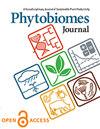Suppression of Phytophthora on Chamaecyparis in sustainable horticultural substrates depends on fertilization and is linked to the rhizobiome
IF 3.3
3区 生物学
Q2 MICROBIOLOGY
引用次数: 1
Abstract
Nature management residues residues (i.e., biomass generated from the management of nature reserves) are promising peat alternatives for horticultural substrates and may have a positive effect on disease suppression because of their microbiological characteristics. Moreover, addition of fertilizer may also affect the rhizosphere microbiome and accordingly disease suppression. In this study, we determined the effect of two management residues in horticultural substrates, i.e., chopped heath and acidified soft rush, and two fertilization regimes, i.e., pure nitrogen fertilizer and compound fertilizer, on the suppression of Phytophthora on Chamaecyparis lawsoniana. The bacterial and fungal rhizosphere community was characterized using 16S rRNA and ITS2 gene metabarcoding. Soft rush with a compound fertilizer (R2) and chopped heath with a pure nitrogen fertilizer (H1) showed a disease suppressive effect and showed the largest shifts in microbial community composition compared to peat-based substrates. The disease suppressive treatments showed differences in their microbial communities. Different genera associated with described biocontrol agents for Phytophthora were found in higher amounts in those treatments. Aspergillus and Trichoderma were highly abundant in H1, while Actinomadura and Bacillus had a high abundance in R2. In addition, the relative abundances of 24 bacterial and 9 fungal genera were negatively correlated with disease severity. Several of those genera, including Bacillus, Chaetomium and Actinomadura, were significantly more abundant in one of the disease suppressive treatments. This study shows that disease suppressiveness in sustainable horticultural substrates is dependent on fertilization and can be linked to changes in the microbial rhizosphere communities.在可持续园艺基质上,对杉霉疫霉的抑制依赖于施肥,并与根瘤菌群有关
自然管理残留物残留物(即自然保护区管理产生的生物质)是很有希望的园艺基质泥炭替代品,由于其微生物特性,可能对抑制疾病产生积极影响。此外,施肥也可能影响根际微生物群,从而抑制病害。在本研究中,我们确定了园艺基质中两种管理残留物,即切碎的石南和酸化的软荆,以及两种施肥制度,即纯氮肥和复混肥,对杉木疫霉的抑制作用。利用16S rRNA和ITS2基因元条形码对细菌和真菌根际群落进行了表征。与泥炭基基质相比,施用复配肥(R2)和施用纯氮肥(H1)的软菜花表现出抑制病害的效果,微生物群落组成变化最大。抑病处理在微生物群落上存在差异。在这些处理中发现与所述疫霉生物防治剂相关的不同属的数量较高。曲霉和木霉在H1中丰度较高,放线瘤菌和芽孢杆菌在R2中丰度较高。24种细菌属和9种真菌属的相对丰度与疾病严重程度呈负相关。其中一些属,包括芽孢杆菌、毛囊菌和放线瘤菌,在一种疾病抑制处理中含量显著增加。本研究表明,可持续园艺基质的疾病抑制作用依赖于施肥,并可能与根际微生物群落的变化有关。
本文章由计算机程序翻译,如有差异,请以英文原文为准。
求助全文
约1分钟内获得全文
求助全文

 求助内容:
求助内容: 应助结果提醒方式:
应助结果提醒方式:


